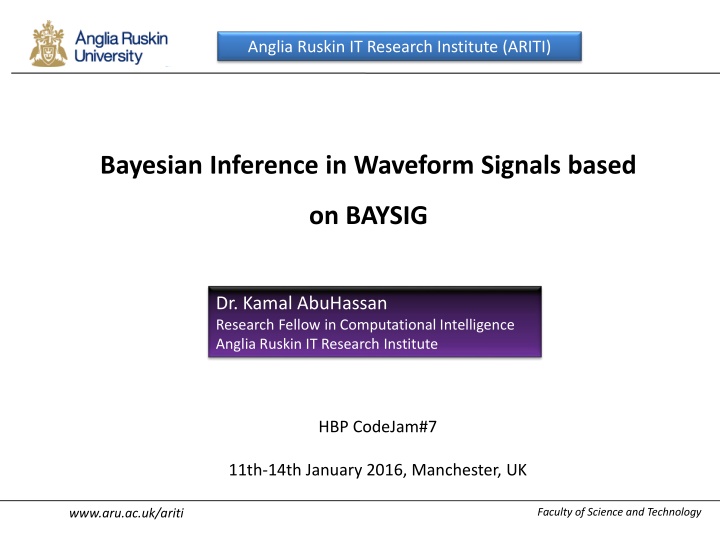
Bayesian Inference Research at Anglia Ruskin IT Institute
Explore the cutting-edge research on Bayesian inference in waveform signals, ECG models, and qIF neuron models at Anglia Ruskin IT Research Institute. Learn about BAYSIG, a new probabilistic modeling language, and the parameter estimation for noisy quadratic integrate-and-fire neuron models using Bayesian inference. Delve into the world of statistical models and data analysis in the field of computational intelligence.
Download Presentation

Please find below an Image/Link to download the presentation.
The content on the website is provided AS IS for your information and personal use only. It may not be sold, licensed, or shared on other websites without obtaining consent from the author. If you encounter any issues during the download, it is possible that the publisher has removed the file from their server.
You are allowed to download the files provided on this website for personal or commercial use, subject to the condition that they are used lawfully. All files are the property of their respective owners.
The content on the website is provided AS IS for your information and personal use only. It may not be sold, licensed, or shared on other websites without obtaining consent from the author.
E N D
Presentation Transcript
Anglia Ruskin IT Research Institute (ARITI) Bayesian Inference in Waveform Signals based on BAYSIG Nauman Aslam Dr. Kamal AbuHassan Research Fellow in Computational Intelligence Anglia Ruskin IT Research Institute HBP CodeJam#7 11th-14th January 2016, Manchester, UK Faculty of Science and Technology www.aru.ac.uk/ariti
Anglia Ruskin IT Research Institute (ARITI) BAYSIG BAYSIG is a new probabilistic modelling language that enhances the expressiveness of statistical models. It has been invented and developed by Dr Tom Nielsen (Founder of OpenBrain Ltd) and funded by the BBSRC grants to Dr Tom Matheson (University of Leicester). It allows you to perform Bayesian statistical inference in a variety of models based on different kinds of data. BAYSIG (https://bayeshive.com). has an online channel known as BayesHive BayesHive has a point-and-click interface to build statistical models and load data. Faculty of Science and Technology www.aru.ac.uk/ariti
Anglia Ruskin IT Research Institute (ARITI) Bayesian Inference in ECG Models Using Bayesian inference to estimate parameters from real ECG data. One aim is to assess the differences in the estimated parameters between healthy subjects and patients with abnormal cardiovascular conditions. Faculty of Science and Technology www.aru.ac.uk/ariti
Anglia Ruskin IT Research Institute (ARITI) Bayesian Inference in qIF Neuron Model AbuHassan K, Nielsen T, Marra V, Hossain A, Matheson T (in preparation) Parameter Estimation for a Noisy Quadratic Integrate-and-Fire Neuron Model based on Bayesian Inference. This research employs Bayesian inference to estimate the parameters of a noisy quadratic integrate-and-fire neuron model from synthetic voltage traces. Summarized results from Bayesian inference The bounding limits for the uniform prior distributions Parameters Actual value Estimated values Mean Deviation -9.58 0.23 -39.93 1.12 0.99 0.03 -79.79 0.17 9.83 0.46 0.106 0.005 Parameters Lower limit -50 mV -60 mV -100 mV -50 pA 0 mV Upper limit 0 mV 0 mV Standard v0 v0 (mV) vthreshold (mV) C (aF) vrest (mV) I (pA) n (mV) -10 -40 1 -80 10 0.1 vthreshold vrest I n vthreshold 50 pA 1 mV Faculty of Science and Technology www.aru.ac.uk/ariti
Anglia Ruskin IT Research Institute (ARITI) Bayesian Inference in qIF Neuron Model AbuHassan K, Nielsen T, Marra V, Hossain A, Matheson T (to be submitted) Parameter Estimation for a Noisy Quadratic Integrate-and-Fire Neuron Model based on Bayesian Inference. A posterior predictive check (PPC) was used to assess the results of parameter estimation. Reference data (red) were compared to the simulated data (blue) generated by the model Sample recording from a regular spiking pyramidal cell responding to in-vivo-like current injection. (Gerstner and Naud, 2009) Faculty of Science and Technology www.aru.ac.uk/ariti






















